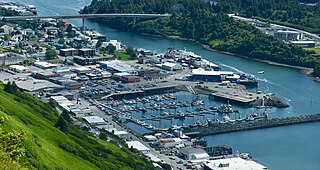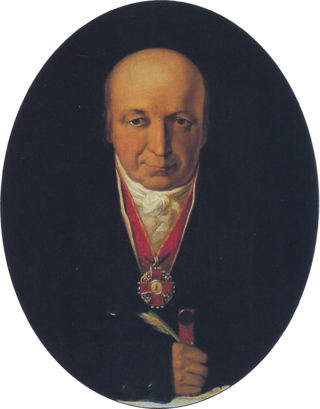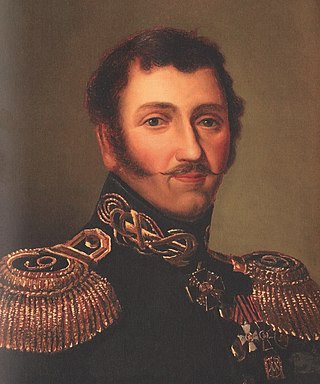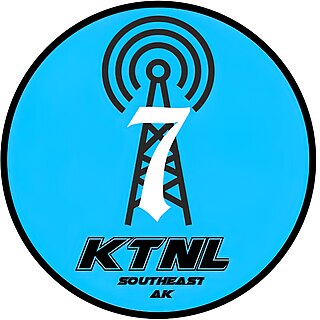
From 1732 to 1867, the Russian Empire laid claim to northern Pacific Coast territories in the Americas. Russian colonial possessions in the Americas are collectively known as Russian America. It consisted mostly of present-day Alaska in the United States, but also included the outpost of Fort Ross in California, and three forts in Hawaii, including Russian Fort Elizabeth. Russian Creole settlements were concentrated in Alaska, including the capital, New Archangel (Novo-Arkhangelsk), which is now Sitka.

Totem poles are monumental carvings found in western Canada and the northwestern United States. They are a type of Northwest Coast art, consisting of poles, posts or pillars, carved with symbols or figures. They are usually made from large trees, mostly western red cedar, by First Nations and Indigenous peoples of the Pacific Northwest Coast including northern Northwest Coast Haida, Tlingit, and Tsimshian communities in Southeast Alaska and British Columbia, Kwakwaka'wakw and Nuu-chah-nulth communities in southern British Columbia,, and the Coast Salish communities in Washington and British Columbia.

Sitka is a unified city-borough in the southeast portion of the U.S. state of Alaska. It was under Russian rule from 1799 to 1867. The city is situated on the west side of Baranof Island and the south half of Chichagof Island in the Alexander Archipelago of the Pacific Ocean. As of the 2020 census, Sitka had a population of 8,458, making it the fifth-most populated city in the state.

The City of Kodiak is the main city and one of seven communities on Kodiak Island in Kodiak Island Borough, Alaska. All commercial transportation between the island's communities and the outside world goes through this city via ferryboat or airline. As of the 2020 census, the population of the city is 5,581, down from 6,130 in 2010. It is the tenth-largest city in Alaska.

Alexander Andreyevich Baranov, sometimes spelled Aleksandr or Alexandr and Baranof, was a Russian trader and merchant, who worked for some time in Siberia. He was recruited by the Shelikhov-Golikov Company for trading in Russian America, beginning in 1790 with a five-year contract as manager of the outpost. He continued to serve past the end date of his contract.

Alaska Day is a legal holiday in the U.S. state of Alaska, observed on October 18. It is the anniversary of the formal transfer of territories in present-day Alaska from the Russian Empire to the United States, which occurred on Friday, October 18, 1867.

Ludwig Karl August von Hagemeister was a Russian naval officer who held the rank of Captain of the 1st rank in the Imperial Russian Navy. He was a maritime explorer of Alaska and the Pacific Ocean, and served briefly in 1817-1818 as the second Chief Manager of the Russian-American Company.

The Battle of Sitka was the last major armed conflict between Russians and Alaska Natives, and was initiated in response to the destruction of a Russian trading post two years before. The primary combatant groups were the Kiks.ádi Clan of Sheetʼká Xʼáatʼi of the Tlingit nation and agents of the Russian-American Company assisted by the Imperial Russian Navy.

KTNL-TV is a television station in Sitka, Alaska, United States, affiliated with MeTV. The station is owned by Ketchikan TV, LLC. KTNL-TV's transmitter is located in downtown Sitka; the station is programmed from studios in Anchorage.
Phoenix was the first ship built in Russian America, for the Shelikhov-Golikov Company, a precursor of the Russian–American Company (RAC). James George Shields, a British mariner in the employ of the Russian Navy, directed her construction, using mainly local materials. The ship was launched at Voskresenskaia on Resurrection Bay in the summer of 1794.

St. Michael's Cathedral is a cathedral of the Orthodox Church in America Diocese of Alaska, at Lincoln and Maksoutoff Streets in Sitka, Alaska. The earliest Orthodox cathedral in the New World, it was built in the nineteenth century, when Alaska was under the control of Russia, though this structure burned down in 1966. After 1872, the cathedral came under the control of the Diocese of Alaska. It had been a National Historic Landmark since 1962, notable as an important legacy of Russian influence in North America and Southeast Alaska in particular.

Castle Hill also known as the American Flag-Raising Site and now as the Baranof Castle State Historic Site, is a National Historic Landmark and state park in Sitka, Alaska. The hill, providing a commanding view over the city, is the historical site of Tlingit and Russian forts, and the location where Russian Alaska was formally handed over to the United States in 1867. It is also where the 49-star United States flag was first flown after Alaska became a state in 1959.

Baranof Island is an island in the northern Alexander Archipelago in the Alaska Panhandle, in Alaska. The name "Baranof" was given to the island in 1805 by Imperial Russian Navy captain U. F. Lisianski in honor of Alexander Andreyevich Baranov. It was called Sheet’-ká X'áat'l by the native Tlingit people. It is the smallest of the ABC islands of Alaska. The indigenous group native to the island, the Tlingit, named the island Shee Atika. Baranof island is home to a diverse ecosystem, which made it a prime location for the fur trading company, the Russian American Company. Russian occupation in Baranof Island impacted not only the indigenous population as well as the ecology of the island, but also led to the United States' current ownership over the land.

Equestrian Statue of Theodore Roosevelt is a 1939 bronze sculpture by James Earle Fraser. It was located on public park land at the American Museum of Natural History in New York City. The equestrian statue depicts Theodore Roosevelt on horseback. Walking on either side of him are two men, on one side a Native American and on the other, a sub-Saharan African.

The Redoubt St. Archangel Michael Site, also known as the Old Sitka Site and now in Old Sitka State Historical Park, is a National Historic Landmark near Sitka, Alaska. Now of archaeological interest, the site, about 7 miles (11 km) north of Sitka at the end of Halibut Point Road, was the site of the early Russian-American Company settlement known as Redoubt St. Archangel Michael. It was the first non-Native settlement on Baranof Island. It was declared a National Historic Landmark in 1962, and was made a state park in 1966.

Nicholas Galanin is a Tlingit and Unangax̂ multi-disciplinary artist and musician from Alaska. His work often explores a dialogue of change and identity between Native and non-Native communities.

More than 160 monuments and memorials to the Confederate States of America and associated figures have been removed from public spaces in the United States, all but five since 2015. Some have been removed by state and local governments; others have been torn down by protestors.

The Monument to Christopher Columbus is a statue by French sculptor Charles Cordier first dedicated in 1877. It was originally located on a major traffic roundabout along Mexico City's Paseo de la Reforma, and was removed on 10 October 2020 in advance of protests.
Lydia was a US merchant ship that sailed on maritime fur trading ventures in the early 1800s. In December 1813 it was sold to the Russian–American Company and renamed Il'mena, also spelled Ilmena and Il'men'. As both Lydia and Il'mena it was involved in notable events. Today it is best known for its role in an 1814 massacre of the Nicoleño natives of San Nicolas Island, which ultimately resulted in one Nicoleño woman, known as Juana Maria, living alone on the island for many years. These events became the basis for Scott O'Dell's 1960 children's novel Island of the Blue Dolphins and the 1964 film adaptation Island of the Blue Dolphins.


















